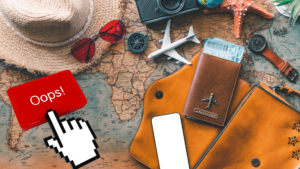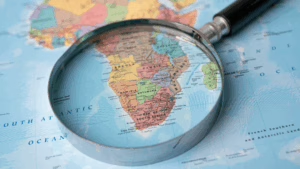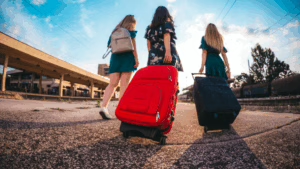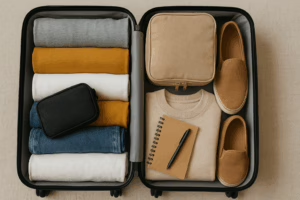Make Sure Everyone Is On The Same Page
Before booking flights or browsing Airbnb listings, have an open conversation. Why is everyone going on this trip? Is it to relax? Sightsee? Adventure? Everyone should feel that their needs are being met.
Discuss goals, budget expectations, and comfort levels. Someone may want to splurge on a boutique hotel, while another is counting every dollar. Get this on the table early to avoid tension later. Create a shared Google Doc or group chat where people can add ideas and vote on must-dos.
This is also the time to determine dates that work for everyone and set clear boundaries. If someone can only go for three days while others want to spend a week, acknowledge that upfront. If necessary, plan for both! This is part of planning around a shared purpose, not just shared excitement.
Choose a Destination That Matches the Group Dynamic
The destination should match your travel personality as a group. A laid-back beach town is perfect for a lower-maintenance crew, while a city full of things to do, art galleries, and museums might appeal to a more ambitious bunch.
Use surveys to gather input. Google Forms is simple, or tools like Doodle can help schedule dates. Consider everyone’s travel style: Do you want walkability, activities, nature, or minimal logistics? Some groups do better in all-inclusive resorts where decisions are minimal. Others thrive on planning and exploring independently.
Make sure the destination matches your budget and energy level. Do not pick a city that requires a jam-packed itinerary if half your group wants to relax at the hotel, at the pool, or on the beach.
Delegate Roles and Responsibilities
Someone should be designated to be in charge. This person (or a few people) can monitor, progress from booking stays, confirming reservations, and sending reminders. If no one takes charge on a group trip, things often fall through the cracks.
Create roles based on interest and strengths. One friend handles lodging, another handles transportation, and someone else researches restaurants and activities. By dividing tasks, you avoid burnout and ensure everyone contributes.
Apps like Splitwise, TravelBank, and TripIt help keep things organized. Use shared folders to hold confirmations and itineraries. Even if you are not the planner, staying informed helps avoid conflict.
Plan the Itinerary with Room to Breathe
Yes, you need an itinerary. No, it does not need to be rigid. The best group trips balance structure with spontaneity.
Block off time for shared activities and anchor moments: a group dinner, a big hike, or tickets to a concert. Then, build in free time where people can go off on their own. It reduces friction and respects personal preferences.
Avoid over-scheduling. When you are with friends, it is tempting to cram everything into one trip. But downtime can be just as memorable. Let people linger over brunch or discover a bookstore on their own. Make room for naps, detours, and last-minute fun.
Handle Money From the Beginning
Money is often the stressor that turns group joy into group drama. Be proactive. Set a rough budget per person from the beginning and talk openly about cost expectations.
Use expense-sharing apps like Splitwise or Venmo to track who owes what. If you are doing shared groceries, create a fund in advance. For restaurant bills, decide in advance: Are we splitting evenly or paying for our items?
Avoid resentment by normalizing honesty. It is OK to say, “That is out of my budget,” or “Can we do something less pricey?” The best groups know how to balance splurges with savings, and nobody should feel pressured to spend beyond their means.
Coordinate Travel Arrangements
Traveling with a group requires extra coordination. Flights should be booked early. Set check-in alerts and share travel plans in a group thread. Staggering arrivals? Designate a meeting point.
Packing can be a team effort, too. Create a shared list: Who is bringing the speaker, the sunscreen, the board games? You do not need five curling irons, but you might want multiple phone chargers. If you are road-tripping, split driving duties and playlists.
And do not forget the essentials: passports, medications, chargers, and emergency contacts. Travel insurance may be a smart option if you are going international or planning expensive activities.
Make the Best of Awkward Situations
Despite your best plans, someone will get cranky, something will go wrong, and you might not all agree. That is OK. Group travel is a lesson in compromise.
Accept that not all of you will move at the same pace or enjoy every single moment. Stay flexible. The best travel moments often come from unexpected places: a random conversation with a local, a shared laugh in a rainy Airbnb, a sunrise you did not plan to see.
Check in with each other throughout the trip. A simple, “Hey, how are you feeling about the trip so far?” can prevent resentment and deepen connection. What matters most is not the perfect photo op but the memories you take home.
Establish a Conflict-Resolution Plan
Even the best-planned group trips can spark conflict. From missed alarms to disagreements about what to do next, friction is inevitable when different personalities and routines collide in tight quarters. Instead of hoping for smooth sailing, anticipate bumps and talk about how you will handle them.
Set a group norm upfront: If someone is upset, they should speak up respectfully. Passive-aggressive comments or silent sulking help no one. If tension arises, suggest taking a break to cool off or splitting into smaller groups for a few hours. Some people may need downtime to reset; others may need to vent.
Having a neutral person step in to mediate can also help if things escalate. If everyone is invested in having a good time, most conflicts can be defused with empathy and a shared sense of humor. Remind yourselves that you are not just traveling together, you are also learning how to navigate group dynamics with grace.
Use Group Chats to Communicate
Group chats are an amazing tool, until they become a never-ending scroll of missed messages. To keep everyone informed without being overwhelmed, be intentional about how you use communication tools.
Start with one main group thread (text, WhatsApp, or Slack) for all planning updates. Pin or star important info—flight times, hotel addresses, dinner reservations, so it is easy to find. For deeper planning, use collaborative tools like Google Docs, Trello, or Notion to organize tasks and links. Some groups even create shared photo albums on Google Photos or iCloud to collect everyone’s memories in one place.
During the trip, daily morning check-ins help. A quick message like “Today’s itinerary: beach at 10, lunch at 1, group dinner at 7” provides structure without needing constant discussion.
Also, sometimes you may need to talk in person. Text cannot convey tone, and misunderstandings easily snowball. If something is unclear or someone seems off, do not assume; just ask.
Get Strategic Pictures
Everyone wants to remember the trip, but not at the expense of living it. When you travel with friends, photos and videos become part of the fun. If you are constantly posing for the perfect Instagram story, you risk missing the actual moment.
Decide as a group how you will capture memories. Will one person be the unofficial trip photographer? Will you create a shared album for everyone to upload to daily? This not only avoids duplicate shots but also makes it easier to compile highlights afterward.
Try to limit excessive phone use during shared moments, like meals or group outings. Designate photo time, then put the phone away.
Journaling can also be a powerful tool. Have everyone jot down a favorite memory or funny moment at the end of each day. You could even turn it into a digital scrapbook or short video montage when you get back.
Plan a Post-Trip Catch-Up
Once the trip ends, the group dynamic does not have to. In fact, how you wrap up a group trip can be just as important as how you begin it. A thoughtful post-trip wind down keeps the connection strong and gives everyone a moment to reflect on what you have shared.
Plan a reunion dinner or video call within a week or two of returning. Share your favorite moments, laugh about the missteps, and trade photos. If the trip was long or intense, a little processing time might be needed, so check in individually, too.
This is also a good time to settle any lingering expenses or wrap up shared logistics. Finalize Splitwise tabs, return borrowed items, and send thank you messages if someone hosted or handled more responsibilities.
You might also want to create a memento—whether it is a printed photo book, a shared video montage, or a playlist of songs from the trip. These little touchpoints help lock in the memories and make everyone feel like part of something special.
TL;DR: How to Travel With Friends
- Align on goals, dates, and budget before you book
- Choose a destination that matches your group vibe
- Assign roles and use apps to stay organized
- Build an itinerary with both shared and solo time
- Discuss money openly and use tools like Splitwise
- Share packing duties and travel logistics in advance
- Embrace the chaos, laugh at the hiccups, and enjoy the ride
- Set a conflict resolution plan before issues arise
- Use group chats and planning tools to communicate clearly
- Capture memories, but stay present in the moment
- Wrap up the trip with intention and connection
















